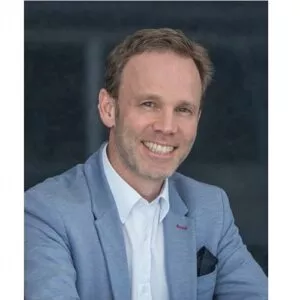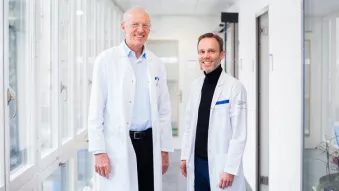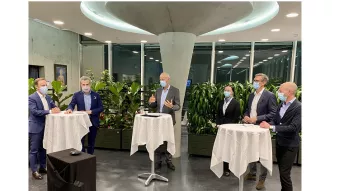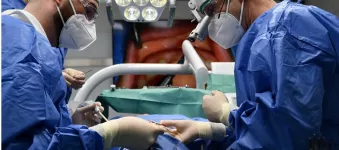
Going beyond the usual course in esthetics: Prof Ronald E. Jung
One of 10 instructing clinicians at a unique upcoming course covering every element of surgical and restorative skills for esthetic treatment, Prof Ronald Jung brings his combined expertise in oral surgery and prosthodontics. Based at the University of Zurich, he shared with us his professional background and motivations, and what makes this advanced three-day course a rare opportunity.
“I started as an oral surgeon, but getting into prosthodontics changed my life”

Despite reaching his high position of Head of Implantology at the University of Zurich, Professor Ronald Jung’s interest in the field came about – quite literally – by accident.
“As a young man, I was a professional soccer player with Grasshopper Club Zurich. Unfortunately, that career ended when I suffered a serious lower leg injury” he says. “I had to have part of my fibula removed – fifteen centimeters is missing.”
For the ever-positive Jung, this traumatic experience sparked an interest in bone regeneration that would pave the way for his career as a clinician, researcher and teacher. He commenced training to become an orthopedic surgeon before switching to dentistry, where he has since specialized both in oral surgery and prosthodontics. His professional and research activity have taken him around the world, including a visiting professorship at Harvard School of Dental Medicine. Best known for his work in the field of hard and soft tissue management, his research focuses on new technologies in implant dentistry.
“I started as an oral surgeon, but getting into prosthodontics changed my life” he says. “I was treating a high volume of implant cases at a private practice, and my colleagues were extremely surprised when I told them I was returning to university to study prosthodontics.”
His reason? “As an oral surgeon I wanted to fully understand, why exactly do I perform every step in the way that I do?”
Now a leader of the board examining postgraduate implantology cases at the University of Zurich, he commented that he often sees how the frame of mind of surgeons and prosthodontists differ. “An oral surgeon might be happy and proud when he creates bone. But for many other details – emergence profile, soft tissue, and so on – you can only know what’s right when you know how the crown will be placed.”
Mastering advanced esthetic cases at each and every step
From October 28–30, Prof Jung will be one of 10 instructing clinicians, led by Prof Christoph Hämmerle, presenting a masterclass in esthetic implant and restorative dentistry at the University of Zurich. The hands-on course features live demonstrations, including surgery that Prof Jung will perform in an anterior case with bone deficiency.
“One of the major strengths of the course is just how comprehensively it covers every single element of the implant workflow.”
“From the initial assessment and digital data acquisition through to all of the planning and surgical steps involved in the reconstructive and prosthetic laboratory work, attendees will be able to really learn what a correct decision-making process should look like for advanced esthetic cases.”
-

Prof. Christoph Hämmerle & Prof. Ronald Jung (Photo:UZH)
-

Center of Dental Medicine, University of Zurich
-

"Mastering Esthetics" Panel discussion, 2020
To his knowledge, there is almost no other university that combines live oral surgery and esthetic dentistry to provide this kind of masterclass. During last year’s iteration – which was held in a virtual capacity due to the COVID-19 pandemic – Prof Jung conducted surgery on a patient with a very challenging case in a central incisor. Several techniques were demonstrated during the surgery, with the use of bone graft material (L-technique) to support implant placement and long-term stability highlighted in particular.
“What makes this course so truly valuable is that participants will be able to understand how all the different details – the bone density, the emergence profile, soft tissue management, prosthetic fabrication and so on – fit together when dealing with challenging cases in the esthetic zone,” Prof. Jung remarks.
Physical event offers new benefits
This year’s course will take place in-person in the beautiful city of Zurich. Participants will not only be able to see Prof. Jung perform implant surgery and guided bone regeneration up close, they will see a live demonstration of treatment planning and guided implantation by Dr. Marc Balmer, and soft tissue augmentation in the esthetic zone to be performed by Prof. Daniel S. Thoma.
They’ll also have the opportunity to work together in groups during practical planning sessions with complex cases. Participants will even have the opportunity to get hands-on with a 3D model of a complex anterior case, allowing them to put their knowledge into practice.
“It’s a small course, not a congress, and so one of the benefits is that there is a great deal more involvement from the attendees,” Prof. Jung says.
“The idea is to be as close as possible to the physical reality so that all of these practical skills that we’ve learned from the presentations and sessions can actually be applied. Really, it should go beyond what you usually learn at a course – that is our goal.”

As someone who is very passionate about education, Prof. Jung is looking forward to meeting clinicians who want to extend their skill set to be able to handle complex esthetic implant cases.
“It’s a true pleasure for me to have other people around and to be able to help them grow professionally. There is nothing that makes me happier than sharing knowledge,” he says. “This type of course gets us as close to clinical reality as possible and I find it the best opportunity to share practical, real-world advice at every single step.